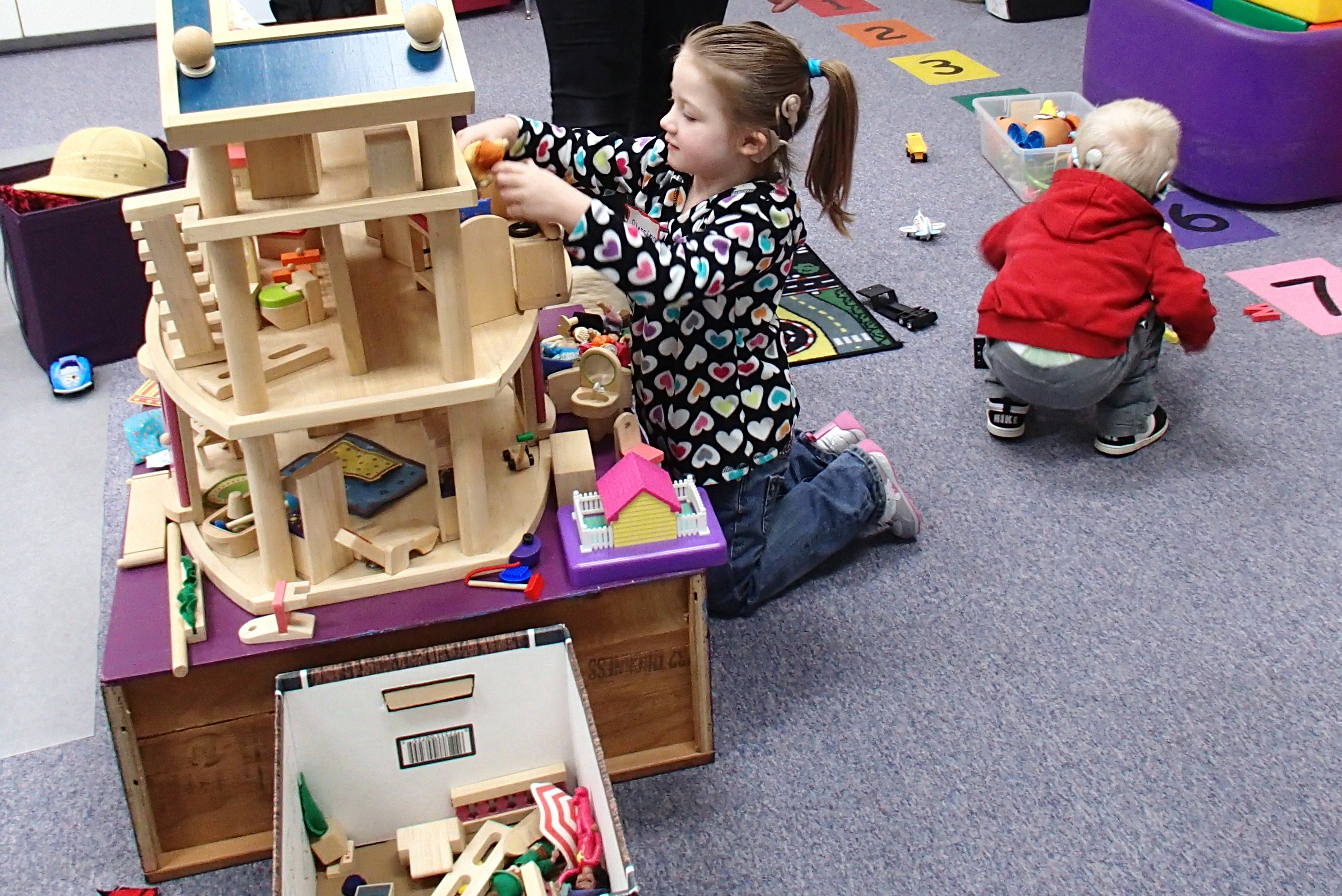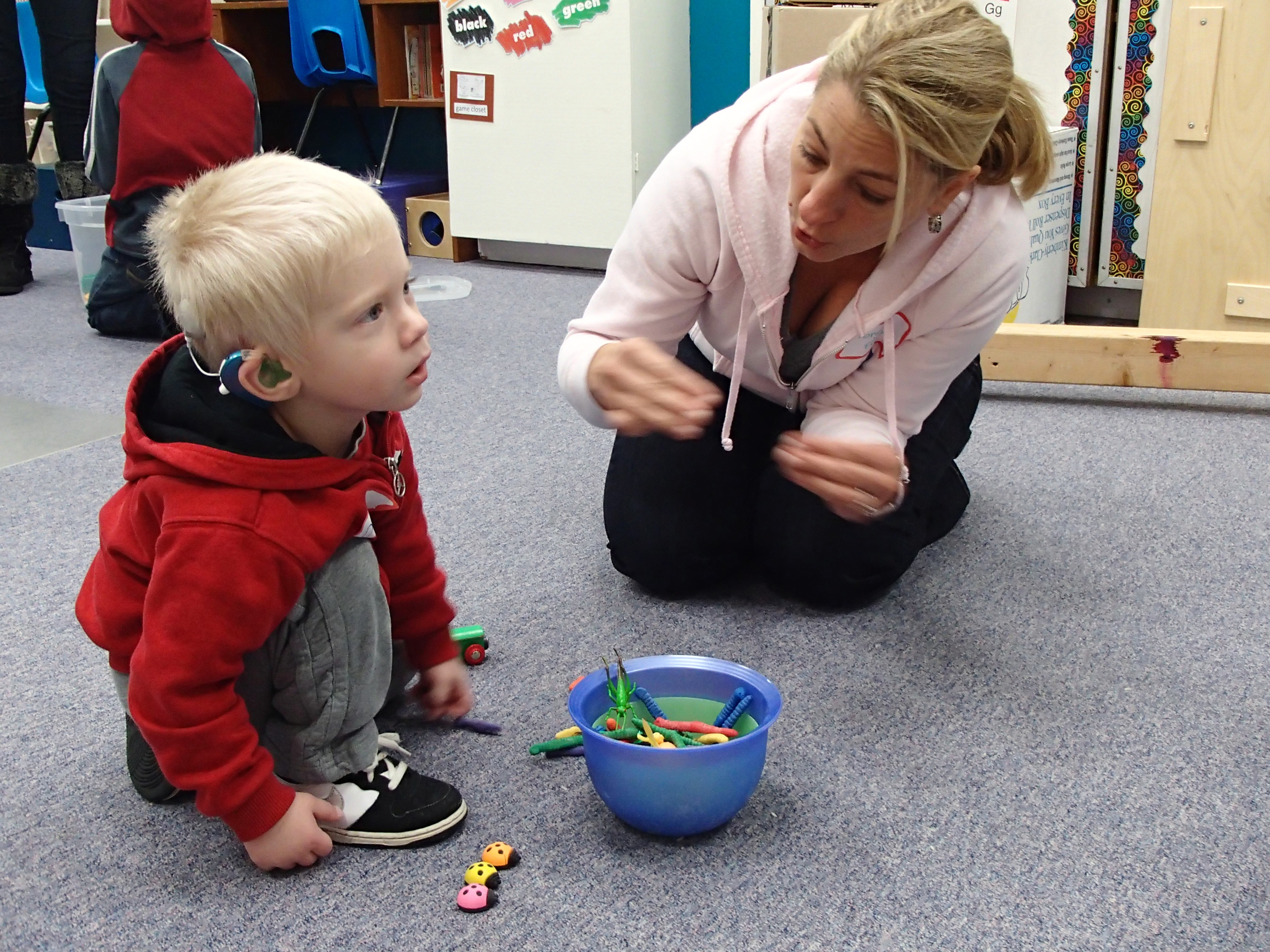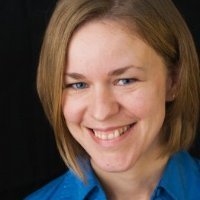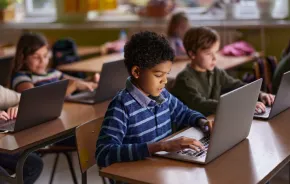 Blessing Hodges and Dane Peterson at a special playgroup hosted by the Northwest School for Hearing-Impaired Children.
Blessing Hodges and Dane Peterson at a special playgroup hosted by the Northwest School for Hearing-Impaired Children.
Dane Petersen, 2½, knelt on the floor of the classroom, playing with plastic bugs.
Suddenly his hand stilled and he looked up. Pop, pop, pop! A few steps away, another group of children were playing with bubble wrap. They had all come to Northwest School for Hearing-Impaired Children in Shoreline for an informal playgroup aimed at families with children who have hearing loss.
“Dane?” A teacher’s assistant spoke his name aloud, and then gestured to gain his attention. “Dane, do you want to see the macaroni? Let’s go see the macaroni.” She drew her hands apart, signing the word for “macaroni” as she said it out loud.
Together they went to a small table, filled with pasta and scoops. Dane dragged an empty can through the yellow mounds. Scrape. patter, patter, patter. He looked up at the assistant and placed his fingers together: “More!”
As her son played, Alyssa Petersen talked about what life has been like since she and her husband Kevin learned that Dane was deaf. A routine hearing test shortly after he was born caught the issue.
After trying hearing aids, Dane received his first cochlear implant in November 2012, and since October of last year has been getting used to his second implant.
“It’s all still really new to him,” said Petersen, of Renton.
Most of it is new to her, too.
Decisions, decisions
From that first diagnosis, parents of children who are deaf or hard of hearing face a host of decisions — large and small — all of them seeming to carry the heavy emotional weight of giving their child a good future.
The Petersens struggled with the decision to fit Dane with cochlear implants, surgically implanted electronic devices that provide a sense of sound. They are close to someone who is deaf and opposes implants.
“There’s that old saying, ‘Why do you have to fix a child who’s not broken?’” Petersen said. “So I debated on that whole issue. But I put it to them this way: I’m going to give him all the tools possible, and then he can choose.”
Opinions about the best way to help a deaf child communicate remain strong.
“The age-old debate over oral- versus sign-based education rages on and, if anything, has increased in intensity in recent years,” wrote Tawny Holmes and Caroline Jackson in a statement for this story. The women are fellows with the National Association of the Deaf in Maryland.
Against that national backdrop, however, educators of the deaf and hard of hearing in Washington State are trying to put that “old news” behind them.
Schools and support groups across Washington are helping to drive a national trend that sets biases aside and focuses instead on what’s best for each child — whether that’s using American Sign Language alone; learning to listen and speak independently with help from a cochlear implant; and every kind of combination in between.
Fresh efforts aim to get disparate groups talking to each other and to offer no-strings-attached help to families of children with profound hearing loss.
Some students still fall through the cracks. The kind of help families seek isn’t always nearby. And expertise is often in short supply.
But state leaders call it progress, and they note that peers at national conferences are interested in “the Washington model.”
“It’s not very common that the different communication modalities are working together,” said Kris Ching, outreach director for birth through preschool at the Washington State Center for Childhood Deafness and Hearing Loss in Vancouver. “We say that it’s not about us sitting around a table. It’s about this child and this family. We need to leave our baggage at the door, which isn’t always easy.”
A lot of work to do
In Washington, the seeds for this new collaborative approach were watered in 2009 when the legislature created the Center for Childhood Deafness and Hearing Loss.
The center oversees the Washington School for the Deaf, a residential school with an American Sign Language-English bilingual program. But the center itself works with multiple communication approaches and aims to come alongside programs across the state to offer support and expertise.
“Washington is a family-choice state, meaning parents have a right to choose the communication modality, and professionals should really support parents to help them find the modality that is best for their child,” Ching says.
“Sometimes school districts think, ‘Oh, we’ll just put an interpreter in there and they’ll learn that way.' But it’s not that simple," she says.
There are multiple approaches to language among the deaf and hard of hearing. Combine that with the relatively low incidence of severe hearing loss — less than one-tenth of one percent in Washington’s public school system — and a shortage of trained staff, and it’s easy for confusion to set in.
At a meeting with parents, Ching recalled a family who used American Sign Language with their deaf son. American Sign Language has its own distinct conventions and sentence constructions. (In several schools across Washington, in fact, ASL is taught as a foreign language.) The family received ASL-driven early intervention services, went through an ASL preschool program — and then was shocked when their son was placed in a kindergarten class that used Signing Exact English, which follows the conventions of spoken English.
More recently, Ching received a call from a preschool teacher in a rural Eastern Washington community who struggled with how to help a boy, almost 4, who was deaf and had a cochlear implant but was unable to speak or fully communicate with sign language.
“She said, ‘I just want to do right by him, but I’ve never worked with a child before who is deaf or has a cochlear implant,’” Ching recalls.
“There’s still a lot of work to do.”
Helping families
The Center for Childhood Deafness and Hearing Loss aims to help families; early childhood programs and school districts alike navigate these waters by sending out teams of experts, including audiologists, speech-language pathologists, teachers of the deaf, early childhood education specialists, school psychologists, language coaches and more.
On top of that, there also are nonprofit groups like Washington State Hands & Voices, whose Guide By Your Side program takes a parent-to-parent approach.
Private schools also are joining the collaborative approach.
The Northwest School for Hearing-Impaired Children in Shoreline contracts with nearly two dozen school districts to provide services to students who are deaf or hard of hearing. The school focuses on developing listening, speech and English-language skills by using speech and Signing Exact English. The method includes saying and signing every part of a word, including prefixes and suffixes (such as pre- and -ly).
Yet staff aim to be a resource to all families finding their way, says Barbara Luetke, the school’s outreach and literacy coordinator. “I get calls from people with questions about IEPs [individual education plans], and it has nothing to do with our school. We just want to be helpful.”
The school also holds mixed playgroups and special events, like movie nights.
“It’s totally all kinds of backgrounds of children. It’s not about one kind of methodology. We’re just trying to get parents together,” Luetke says.
Parent support is crucial. In more than nine out of 10 cases, children with profound hearing loss live in homes with hearing parents.
That may be a major reason why it’s not so much about how a child communicates, only that she can communicate — and with her own family, first and foremost.
Findings from a 2010 study by the University of Washington and University of Colorado, which surveyed 230 teens who are deaf or hard of hearing, back up that belief. Signing or speaking, going to a mainstream school or a school for the deaf, having a cochlear implant or not — none of that was as key to a teen’s quality of life as being able to understand his parents.
Tonya Fuqua, a teacher's assistant at the Northwest School for Hearing-Impaired Children, asks Dane Petersen if he would like to play at a sensory table filled with macaroni.
No easy answers
Language is best learned early in life, so decisions about how a deaf child should communicate typically come early. But that’s no easy task.
At the same time cochlear implants are rapidly gaining acceptance, there is a vibrant deaf culture in the Seattle area, with professional networking and arts groups.
Ching worries about too much pressure being placed on families too soon.
“Sometimes parents are pushed to make a decision about a communication modality when their child is only 3 months old and they’re still bonding. [We need to be] giving them opportunities to explore … and see what best matches their child and would be good for the whole family,” she says.
Sometimes decisions can’t be made early, such as adopting an older child with hearing loss.
Then there’s little Blessing Hodges, age 5.
Kandi and David Hodges recently moved to Marysville from Oklahoma to be near family. When she was a baby, Blessing passed some hearing tests and failed others. By age 3, she still wasn’t talking, and her parents knew she wasn’t just “a late talker” as her pediatrician surmised.
After going from clinic to clinic for four years, a well-regarded specialist finally pinpointed the issue. Blessing has auditory neuropathy. Sound enters her inner ear normally, but the transmission of signals from the inner ear to her brain is impaired. As the specialist put it, Blessing could hear her parents speaking, but the sound came through like static or as if they were underwater, Kandi Hodges says.
After trying hearing aids, they switched to cochlear implants. Blessing received her first implant in December 2012 and the second one in April 2013.
“She’s so much happier,” Hodges said. “Before, she was so frustrated and angry because she couldn’t get her point across. Now she’s putting a couple of words together, and a couple natural sounds — before she was just grunting. Now she can start to sign things out.”
The Hodges are getting help from Seattle Children’s well-regarded audiology program. They’re also waiting on paperwork to start the formal process of getting a referral from Marysville School District to an appropriate program that will help Blessing continue to develop.
“About all we can do is take things one day at a time and hope she gets there. All of this is brand-new to me,” Hodges says. “She hasn’t been a listener for long. But every day I see so much improvement. She blows me away sometimes.”
Tips from parents
Most parents have children with normal hearing. Some tips from parents of children who are deaf or hard of hearing:
Don’t be afraid to ask questions. “I know sometimes, especially with the cochlear implants, the kids can look kind of scary. I have no problems with someone coming up to me and asking,'What is that?'” parent Alyssa Petersen says.
Make a point to include hearing-impaired children in play. “Encourage the kids to accept these children because they feel left out so many times, and all they want is what everyone else wants, too — to be accepted,” parent Kandi Hodges says. “That’s probably the hardest part — to watch them struggle — because they want to interact with the other kids, and the other kids just kind of ignore them.”
Keep an open mind. Opinions remain strong about the best way to teach a child who is deaf how to communicate. Respect the path chosen by each family. “Everyone needs to make their own decisions,” Petersen says.
Where to go for help
Some of the resources available to families with children who are deaf or hard of hearing:
Places to start
• Department of Health, Early Hearing Loss Detection Diagnosis & Intervention (EHDDI); 206-418-5613
• Washington State Hands & Voices, Guide By Your Side Program; 425-268-7087
• Seattle Children’s Hospital, Childhood Communication Center and Hearing Loss Clinic; 206-987-3853
• Washington State Center for Childhood Deafness and Hearing Loss, Statewide Outreach Services (website under construction); 855-342-1670; outreachteam@cdhl.wa.gov
• Washington State Department of Early Learning, Early Support for Infants and Toddlers or the local Family Resources Coordinator for your county; Family Health Hotline at 800-322-2588
• Department of Social and Health Services, Office of the Deaf and Hard of Hearing; 800-422-7930
• Washington Sensory Disability Services, Washington Deaf-Blind Project; 800-572-7000
Other resources
• Washington Sensory Disabilities Services lending library
• Hearing, Speech & Deafness Center; 206-323-5770
Activities
• ASL classes: Hearing, Speech & Deafness Center; 206-323-5770
• Signing Exact English classes: Seattle Children’s Family Conversations, in King and Pierce counties. Email Alisa George or call: 425-482-4178
• Family Academy Nights at Washington School for the Deaf, meets 5–7 p.m. every third month in the elementary school building for families with children ages birth to grade 3. Activities include dinner, parent workshops and child-focused activities. Interpreters provided. Contact Shauna Bilyeu (overnight accommodations available for families outside of southwest Washington)
• Playgroups: Washington State Hands & Voices calendar (various groups, including ASL playgroup at Alderwood Mall); Northwest School for Hearing-Impaired Children (ages 1–7, all communication methods; RSVP required); Washington School for the Deaf (birth to age 3, meets 10–11:30 a.m. on Thursdays; contact Kerianne Christie or call: 360-418-4365)
• Family Camp: Washington Sensory Disabilities Services, in collaboration with the Center on Childhood Deafness and Hearing Loss, sponsors a weekend getaway each spring for families with children and teens who are deaf or hard of hearing. Families stay in cabins at the Lazy F Ranch outside of Ellensburg, attend workshops, and have fun. For more information, contact Carol Carrothers or call 509-963-1131.
• Deaf Fiesta: Washington Sensory Disability Services and Center for Childhood Deafness & Hearing Loss sponsor a Saturday gathering for Latino families that have children who are deaf or hard of hearing. Families meet at Central Washington University for parent workshops and children activities by age group and lunch. Interpreters provided. For more information, contact Carol Carrothers or call 509-963-1131.
Schools and programs
This is a partial list. Families should start with their local school district’s special education office.
• Several school districts have large programs for the deaf and hard of hearing, reflecting a variety of communication approaches. Larger programs can be found in Anacortes, Edmonds, Evergreen, Federal Way, Pasco, Puyallup, Seattle, Sunnyside, Tacoma and Yakima. Most of these programs also offer sign language classes for parents/families.
• Listen & Talk, Seattle (listening and spoken language); 206-985-6646
• Northwest School for Hearing-Impaired Children, Shoreline (Signing Exact English); 206-364-4605
• Hearing Speech and Deafness Center early learning programs, including the Ned Behnke Speech Language Preschool in Seattle (Cued Speech); 206-323-5770 or 206-388-1284
• Washington School for the Deaf, Vancouver (American Sign Language-English bilingual); 360-696-6525
• Spokane HOPE School (listening and spoken language); 509-828-1379
• Seattle Children’s Family Conversations Program; 425-482-4185
• MOOSE Project (Magic of Oral and Signing Education), Spokane (American Sign Language and spoken English), Kristi Anderson at 509-443-5905 or mooseproject@comcast.net











